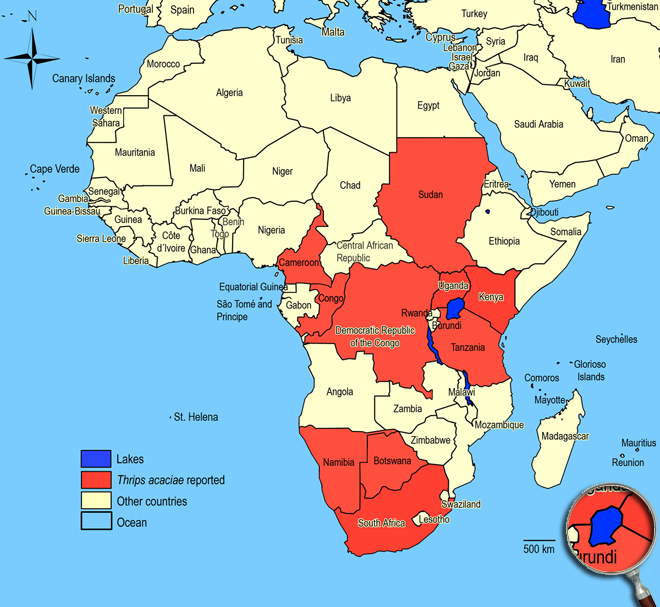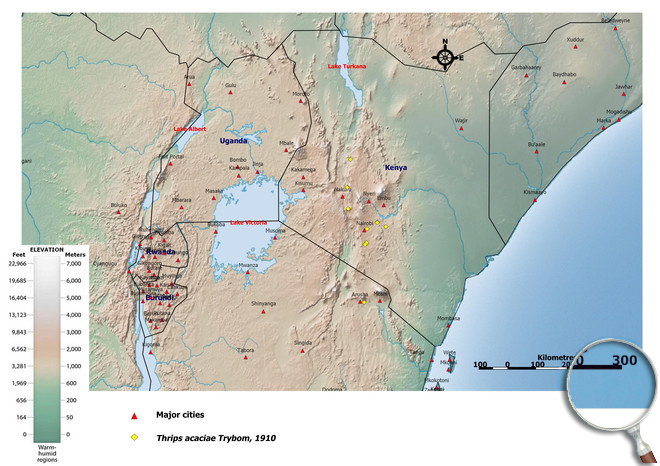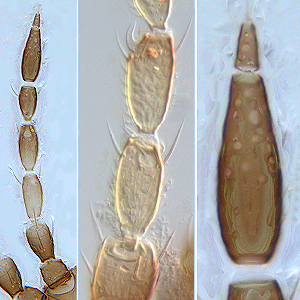Thrips acaciae Trybom, 1910
Thripinae, Thripidae, Terebrantia, Thysanoptera
Figures
Fig. 1: 7-segmented antenna, segments III and IV with forked sense cone, terminal segments VI and VII
Fig. 2: Head dorsal with ocellar triangle
Fig. 3: Pronotum
Fig. 4: Meso- and metanotum
Fig. 5: Fore wing and fore wing distal region
Fig. 6: Meso- and metasternum
Fig. 7: Sternites V and VI
Fig. 8: Tergites VI and VII
Fig. 9: Tergites VIII and IX
Fig. 10: Tergites IX-XI
Introduction and recognition
Thrips acaciae causes damage particularly on flowers of Acacia, coffee, Diospyros sp. (ebony), mango, sweet potato and fabaceous forage plants. Both sexes fully winged. Body color brown; fore tibiae and tarsi yellow; antennal segments I & II brown, III mainly yellow, IV & V yellow at base, VI & VII brown; fore wings brown shaded with base paler. Antennae 7-segmented; segments III & IV slightly constricted at apex and with forked sense cone (Fig. 1). Head wider than long; with 2 pairs of ocellar setae, pair I absent, pair III arising on anterior margin or outside of ocellar triangle (Fig. 2). Pronotum with many transverse sculpture lines not closely spaced; about 40 discal setae; 2 pairs of moderately elongate posteroangular setae (about 0.3 as long as pronotum); posterior margin with 4-5 pairs of setae; anterior margin with 4-6 pairs of setae (Fig. 3). Metanotum median area sculptured lines with mainly equiangular reticulation, medially with longitudinal row of large slightly elongate reticles; median setae longer than lateral setae and arising behind anterior margin; campaniform sensilla present (Fig. 4). Mesofurca with spinula (Fig. 6). Mid and hind tarsi 2-segmented. Fore wing first vein with 2-5 (mostly 3) setae on distal half; second vein with a complete row of about 9-13 setae; clavus with 5-8 marginal setae and 1 discal seta, clavus terminal seta longer than subterminal seta (Fig. 5). Tergite II with 4 lateral marginal setae; tergites V-VIII with ctenidia present laterally (Fig. 8), on VIII posteromedial to spiracles; tergite VIII posterior margin with weak but complete comb of small and irregular microtrichia (Fig. 9 and 10); pleurotergites without discal setae, but with weakly dentate or slender microtrichia on widely spaced lines of reticulation. Sternite II with 2 pairs of marginal setae; III-VII with 3 pairs of marginal setae (Fig. 7), the median pair on VII arising in front of posterior margin; sternite II with 2-3 discal setae, III-VII with 14-24 short discal setae in two irregular rows.
Male similar to female in structure, but smaller and paler; tergite VIII with no marginal comb; tergite IX with transverse row of 4 equally-spaced setae medially; sternites III-VII with transverse glandular area anterior to row of discal setae.
Taxonomic identity
Species
Thrips acaciae Trybom, 1910
Taxonomic history
Thrips hirtiventris Hood, 1932
Thrips spadix Hood, 1932
Thrips kikuyuensis Trybom, 1912
Common name
-
Present taxonomic position
Family: Thripidae Stephens, 1829
Subfamily: Thripinae (Stephens) Karny, 1921
Genus: Thrips Linneaeus, 1758
Genus description
The genus Thrips L., 1758
There are nearly 300 species currently recognized in the genus Thrips making this genus one of the largest taxa within the order Thysanoptera. The genus was redefined progressively during the 1970's (see Mound et al. 1976), to include many species previously placed in Taeniothrips. The genus Thrips now includes a range of species, some with the antennae 7-segmented, others 8-segmented, and a few with the number of segments varying between 7 and 8. Similarly, some species have few setae on the fore wing first vein, whereas others have a complete row of setae on this vein. The species with a complete setal row on the first vein were placed from some taxonomists in the genera Isothrips or Isoneurothrips. However, all of the species in Thrips have the following character states: antennal segments III & IV with forked sense cone, absence of ocellar setae I, pronotum with 2 pairs of elongate posteroangular setae, paired ctenidia laterally on the tergites V-VIII, tergite VIII ctenidium arising posterior to the spiracle (in contrast to species of the genus Frankliniella). Other character states, such as number of antennal segments, number of setae on the fore wing veins, and number of discal setae on the abdominal sternites are variable between species (Mound & Masumoto 2005; Nakahara 1994; Palmer 1992). Identification keys are available for the species of this genus from many parts of the world. Of particular importance is the published key by Mound (2010) for members of the genus Thrips from Afro-tropical region as well as previous Lucid keys from Moritz et al. (2001, 2004, 2009).
Species description
Typical key character states of Thrips acaciae
Coloration and body sculpture
Body color: mainly brown to dark brown
Surface of head, pronotum and fore legs: without obvious or with weakly reticulate sculpture
Antennae
Number of antennal segments: 7
Antennal segment I: without any setae on dorsal apical margin
Antennal segment II: without an exceptionally long seta at the inner apex
Antennal segment II shape: symmetric
Antennal segment III shape: symmetric
Length of antennal segment III and IV: antennal segment III similar in length to segment IV
Form of sense cones on antennal segments III and IV: emergent and forked on segments III and IV
Forked sense cone on antennal segment IV: scarcely extending beyond base of segment V
Antennal segment IV and V: without a hyaline ring near the base
Antennal segment VI bears: not a remarkably dagger-shaped sensorium
Head
Distance between bases of ocellar setae III: greater than width of first ocellus
Head: not prolonged in front of compound eyes
Ocellar setae I: absent
Length of ocellar setae II: shorter than setae III
Ocellar setae III: arising on anterior margin of, or in front of ocellar triangle
Ocelli: present
Length of postocular setae: not alternating short and long setae
Number of ocellar setae: 2
Prothorax
Number of pairs of anteromarginal minor setae: 4-6
Number of pairs of long anteroangular setae: 0
Number of pairs of long posteroangular setae: 2
Number of pairs of elongate pronotal setae: 2
Number of pairs of posteromarginal minor setae: 4-5
Pronotal blotch or internal apodeme: absent
Pronotum shape: broadly rectangular
Pronotum posteromarginal/posteroangular setae: S2 longer than S3, not equal in length
Mesothorax
Mesosternal furca: with median spinula
Metathorax
Metanotal campaniform sensilla: present
Metanotal median setae: S1 behind anterior margin
Metanotum with dominant sculptured triangle medially: absent
Metasternal furca: without spinula
Sculpture of metanotum median area: with mainly equiangular reticulation
Shape of metathoracic furca: transverse, V-shaped
Metanotal median setae length: longer than lateral metanotal setae
Wings
Fore and hind wings: present, more than half as long as abdomen (macropterous)
Fringe cilia arising: from sockets
Fore wing veins: present
Fore- and hind wing surface: covered with microtrichia
Apex of fore wing: with prominent terminal setae
Fore wing anterior margin (costal vein): with setae and cilia but cilia longer than setae
Fore wing clavus - number of marginal setae: 5-8
Fore wing clavus - terminal veinal seta: longer than subterminal seta
Fore wing costal fringe cilia: arising at anterior margin of wing
Fore wing first vein: distinct from costal vein
Fore wing first vein setal row: incomplete, with setae not closely and uniformly spaced
Fore wing second vein setal row: complete, setae uniformly spaced
Fore wing shape: mainly parallel sided or margins run continuously towards each other
Fore wing surface: not reticulate
Fore wing first vein number of setae on distal half: (2) 3 (4-5)
Fringe cilia on posterior margin near apex: distinctly wavy (undulated)
Shape of fore wing apex: with mainly posterior margin curved to join anterior margin
Fore wing: entirely brown brown, sometimes with slightly pale areas subapically, medially and subbasally or uniformly dark or shaded, but with base or sub-base pale
Fore wing extreme apex color: dark
Legs
Fore tibia: not prolonged around fore tarsus
Mid and hind tarsi: with two segments
Color of fore tarsi: pale or yellow, sometimes apical shaded or brown
Abdomen
Pleurotergal discal setae: absent
Pleurotergites: with many rows of fine microtrichia
Number of pleurotergal discal setae: 0
Sternite II: with marginal setae and few discal setae
Number of discal setae on sternites III to VI: 14-24
Sternites IV, V and VI: with marginal setae and discal setae medially
Pairs of posteromarginal setae on sternites V and VI: 3
Sternite VII median posteromarginal setae S1: arising in front of posterior margin
Sternite VII: with marginal setae and discal setae present on median area
Surface of lateral thirds of abdominal tergites: without regular rows of fine microtrichia
Number of lateral marginal setae on tergite II: 4
Tergites II to VII median setal pair: no more than 0.3 as long as median length of tergite
Sculpture of tergites II to VIII: with one or without transverse lines of sculpture between median pair of seta S1
Craspedum on tergites IV to VI: absent
Tergites IV and V median setal pair: shorter than distance between their bases
Markings on tergites IV to VI: without shaded area medially
Tergites V to VII: with ctenidia laterally
Craspedum on tergite VIII: without craspedum medially and toothlike microtrichia laterally
Tergite VIII ctenidia: posteromedial to spiracle
Tergite VIII posteromarginal comb of microtrichia: present and complete medially
Tergite VIII shape of posteromarginal microtrichia: short and irregular in length
Color of tergites IX and X: dark or brown
Tergite X: not tubular, longitudinally incomplete
Setae on abdominal tergite X: all setae slender

Similar or related species
Thrips acaciae is very similar to some other Thrips species - like Thrips brevisetosus, Thrips florum, Thrips gowdeyi, Thrips hawaiiensis and Thrips simplex. Thrips acaciae has sternites III-VII with at least 1 pair of discal setae and pleurotergites without discal setae (Thrips australis, Thrips microchaetus, Thrips subnudula and Thrips tenellus, all of them have sternites III-VII with at least 1 pair of discal setae and pleurotergites with discal setae; Thrips orientalis and Thrips parvispinus with discal setae on sternites III-VI but not on sternite VII, and without discal setae on pleurotergites; Thrips nigropilosus, Thrips palmi, Thrips pusillus and Thrips tabaci, all of them have sternites and pleurotergites without discal setae).
Inside this group almost all species have the ocellar setae III on head arising on anterior margin of, or in front of, ocellar triangle, and the fore wing first vein with less than 5, mostly 3, setae on distal half (only Thrips simplex with ocellar setae III arising within ocellar triangle anterior to tangent of anterior margin of hind ocelli, and fore wing first vein with 6-10 setae on distal half). Most of them exhibit campaniform sensilla on metanotum (except for Thrips gowdeyi and Thrips simplex without metanotal campaniform sensilla), and 2 pairs of elongate pronotal posteroangular setae (except for Thrips brevisetosus without elongate pronotal setae). In Thrips acaciae as well as Thrips brevisetosus, Thrips gowdeyi and Thrips simplex the metanotal median setae arise behind anterior margin (in Thrips florum and Thrips hawaiiensis median setae arise at anterior margin). As Thrips brevisetosus, the species have always 7-segmented antennae (in Thrips gowdeyi and Thrips simplex antennae are always 8-segmented; in Thrips florum and Thrips hawaiiensis antennae are 7- or 8-segmented) and a mainly equiangular reticulation on metanotal median area. Whereas in other species the metanotal median area exhibit transverse sculptured lines at anterior, but longitudinal or equiangular reticulations on posterior half (Thrips gowdeyi and Thrips simplex), always longitudinal and parallel sculptured lines on posterior half (Thrips florum), or longitudinal and parallel sculptured lines or equiangular reticulations on posterior half (Thrips hawaiiensis). Furthermore, Thrips acaciae possesses rows of fine microtrichia on pleurotergites, situated on widely spaced lines of reticulation (as in Thrips gowdeyi and Thrips simplex; in Thrips brevisetosus, Thrips florum and Thrips hawaiiensis these rows of microtrichia are absent). Outside this group, also Thrips tabaci and Thrips subnudula have pleurotergites covered with rows of fine microtrichia.
Species of the genus Thrips are similar to species of Stenchaetothrips, Microcephalothrips abdominalis, Larothrips dentipes and Fulmekiola serrata because of tergites V-VIII bear a pair of ctenidia laterally, which on tergite VIII lie posteromedial to the spiracle, and all species have no ocellar setae I. In contrast to species with craspedum on tergites II-VII (Microcephalothrips abdominalis, Larothrips dentipes and Fulmekiola serrata), species of Thrips and Stenchaetothrips have no posteromarginal craspedum on tergites and sternites. Species of the genus Thrips as well as Fulmekiola serrata and species of Stenchaetothrips have 2 pairs of elongate posteroangular setae (Microcephalothrips abdominalis with 2 pairs of moderately elongate pronotal setae and Larothrips dentipes without elongate setae). Compared to species of Thrips, and Microcephalothrips abdominalis, and Larothrips dentipes, which have ocellar setae II much shorter than or about as long as III, Fulmekiola serrata and species of Stenchaetothrips have ocellar setae II much longer than III, and sternites always without discal setae.
Biology
Life history
As with other thrips species the life cycle from egg to adult is dependent on temperature. The full cycle can take about 15 days (Lewis 1973) to over a month. Adults may live for more than one month producing several generations in one year depending on seasons. With greenhouse temperatures the developmental time from egg to adult can decrease to about one week.
Host plants
Polyphagous.
Crops: Acacia sp., African spiderplant, coffee, Diospyros sp. (ebony), maize, mango, sweet potato.
Weeds: Ajuga remota, Aspilia pluriseta, Bothriocline longipes, Crotalaria pycnostachya, Erlangea calycina, Galinsoga parviflora, Indigofera hilaris, Lantana camara, Lantana trifolia, Lessertia brachystachya, Senecio diversifolius, Tagetes minuta, Vernonia lasiopus.
Vector capacity
None identified, but possible mechanical distribution of phytopathogenic fungi and bacteria.
Damage and symptoms
-
Detection and control strategies
-
Additional notes
-
Biogeography
Africa. Botswana (Kalahari, Kooa Pan), Cameroon, Congo (Rutshuru), Kenya,
Namibia (Kalahari),
South Africa (Gauteng: Pretoria; Limpopo: Limpopo: Zebediela Estates, Mokopane, Satara - Kruger National Park; North West: Rietspruit - Marico district; KwaZulu-Natal: Mtubatuba, Amatikulu, Dukuduku Forest, Richards Bay; Cape Provinces), Sudan,
Tanzania (Rufigi River), Uganda (Kampala, Morogoro, Mpumumpu, Rubaja).
African countries where Thrips acaciae has been reported

Occurence of Thrips acaciae in East Africa

Please click here for survey sites of all observed thrips species of Kenya, Tanzania and Uganda.
Click here for locations of Thrips acaciae in parts of East Africa.

Bibliography
Faure JC (1964). Thysanoptera of Africa - 9. Revue de Zoologie et de Botanique Africaines. 70 (1-2): 53-91
Hood JD (1932). New species of the genus Thrips from Central Africa and Egypt. Bulletin de la Société Royale Entomologique ďEgypte. 16/17: 115-140
Karny H (1925). On some tropical Thysanoptera. Bulletin of Entomological Research. 16 (2): 125-142
Lewis T (1973). Thrips: their biology, ecology and economic importance. Academic Press Inc., London Ltd., 349 pp
Moritz G, Morris DC & Mound LA (2001). ThripsID - Pest thrips of the world. ACIAR and CSIRO Publishing Collingwood, Victoria, Australia, CDROM ISBN 1 86320 296 X
Moritz G, Mound LA, Morris DC & Goldarazena A (2004). Pest thrips of the world - an identification and information system using molecular and microscopical methods. Centre for Biological Information Technology, University of Queensland, Australia, CDROM ISBN 1 86499 781 8
Moritz G, O'Donnell C & Parrella M (2009). Pest thrips of North America. Centre for Biological Information Technology, University of Queensland, Australia, CDROM ISBN-13: 978 1 86499 940 2
Mound LA (2010). Species of the genus Thrips (Thysanoptera, Thripidae) from the Afro-tropical Region. Zootaxa. 2423: 1-24
Mound LA & Masumoto M (2005). The genus Thrips (Thysanoptera, Thripidae) in Australia, New Caledonia and New Zealand. Zootaxa. 1020: 1-64
Mound LA, Morison GD, Pitkin BR & Palmer JM (1976). Thysanoptera. Handbooks for the identification of British insects, Vol. 1, Part 11. Royal Entomological Society of London, London, 79 pp
Nakahara S (1994). The genus Thrips Linnaeus (Thysanoptera: Thripidae) of the New World. Technical Bulletin, USDA, Agricultural Research Service. 1822: 1-183
Palmer JM (1992). Thrips (Thysanoptera) from Pakistan to the Pacific: a review. Bulletin of the British Museum (Natural History), Entomology. 61 (1): 1-76
Trybom F (1910). Physapoda. In Schultze L [ed.], Zoologische und anthropologische Ergebnisse einer Forschungreise im westlichen und zentralen Südafrica, ausgeführt in den Jahren 1903-1905 mit Unterstützung der kgl. Preussischen Akademie der Wissenschaften zu Berlin. Denkschriften der Medizinisch-Naturwissenschaflichen Gesellschaft zu Jena. 16 (4): 147-174
Trybom F (1912). Physapoden, gesammelt von der Schwedischen Expedition nach dem Brittischen Ostafrika. Arkiv für Zoologi. 7 (22): 1-12
zur Strassen R (1960). Catalogue of the known species of South African Thysanoptera. Journal of the Entomological Society of Southern Africa. 23 (2): 321-367
----
Web links
Mound´s Thysanoptera pages
Thysanoptera Checklist
ICIPE Thrips survey sites
UNI Halle & Thrips sites
Thrips of California














